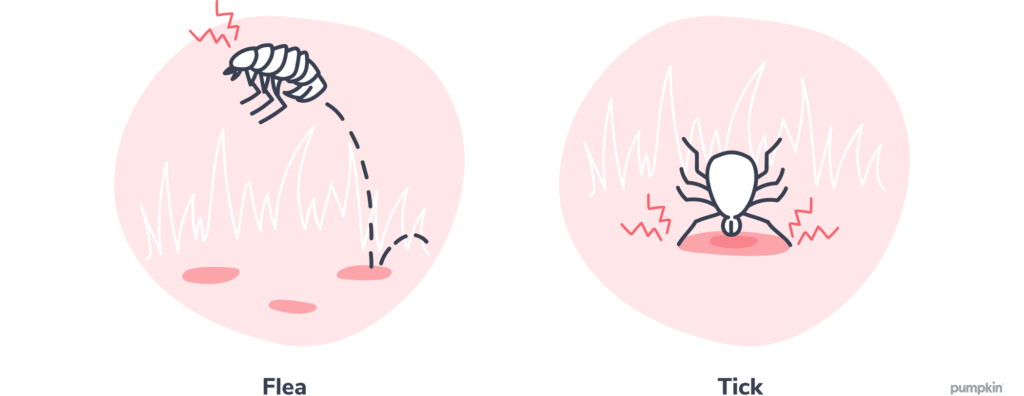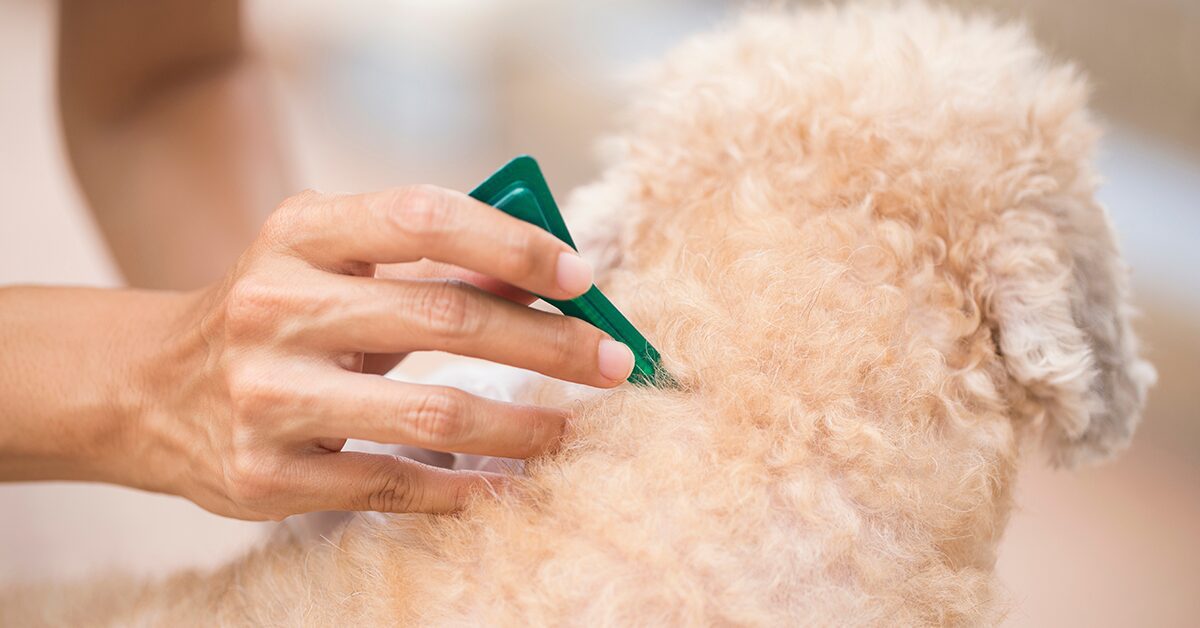Key Points
- The most effective form of flea and tick prevention for dogs is a routine oral parasiticide (like Simparica Trio) alongside regular body checks, and good grooming habits.
- Some dog owners may use flea and tick collars, drops, or sprays in addition to parasiticides if they live in a high-risk environment or heavily wooded area.
- Always consult your vet before purchasing any flea and tick preventative.
If you’re a dog owner, you know that flea and tick prevention is essential. These parasites can be quite an unpleasant surprise, quickly latching onto your dog and burrowing into their fur.
Though small, fleas and ticks can cause major health issues ranging from mild skin irritation to serious tick-borne diseases like Lyme disease. But the good news? They are easily preventable with the right care.
The difference between fleas and ticks
Fleas and ticks are tiny, wingless parasites with six legs that latch onto their host and live off their blood. If left untreated, fleas and ticks could result in an infestation as they reproduce on your dog. Believe it or not, a female flea can lay 40 to 50 eggs daily and lay thousands in its life cycle! Although tiny, they can carry a powerful, infectious bite that cause extreme itchiness and skin irritation. If you see a tiny trail of what looks like dirt or coffee grounds on your pooch, they could have fleas.
Ticks are also small parasites that live off their host’s blood but tend to be more visible than fleas. They have eight legs and usually appear more bulbous-shaped. It’s extremely important to check your dog for ticks frequently if you live in a wooded area or go on a lot of outdoor adventures. If a tick makes itself at home on your dog, illnesses such as Lyme disease or rocky mountain spotted fever can arise.

How do dogs get fleas or ticks?
Unfortunately, the answer to this question can be as simple as taking your dog for a walk. Dogs often pick up fleas and ticks during everyday adventures.
Whether frolicking at the local park, romping in the backyard, or exploring wooded areas with canine pals, these little creatures can hop onto your pet.
Keeping your dog completely flea- and tick-free can be challenging, but fret not! Embracing preventive measures can help keep your dog happy, healthy, and parasite-free.
How to protect your dog from fleas and ticks
Learning how to protect your dog from ticks and fleas is the first step toward prevention. So what do you need to know?
For starters, you can prevent these parasites by using effective flea and tick preventatives. However, with so many over-the-counter flea and tick products, it can be tough to choose one that is high-quality and safe.
Our advice? Consult with your veterinarian to make an informed decision, as certain preventative medications might not suit everyone. Remember, a routine oral parasiticide (like a Simparica Trio) is a necessity – anything else you choose is just an extra layer of protection!
Tick and flea collars
Flea and tick collars can be a good option alongside routine parasiticides, especially for those who live in heavily wooded areas – however, it’s extremely important to do your research and discuss this preventative with your vet first. Some flea and tick collars contain chemicals that can be dangerous to you and your pet’s health.
There are two types of collars: one that releases a repellent odor that repels and kills adult fleas and ticks, and another that slowly releases a chemical repellent into your dog’s sebaceous glands and hair follicles. This repellent spreads through your dog’s natural oils providing longer-lasting prevention. Again, do your research and understand the risks before making any decisions.
Topical treatment
Spot-on or topical medication is another flea and tick prevention product that you can use. These products usually come in drops and are applied to your dog’s skin on a routine basis such as once a month. Similar to tick and flea collars, this product works by depositing chemicals into your dog’s sebaceous glands that ward off ticks, fleas, and in some cases, mosquitoes. As always, talk to your vet before purchasing any medication for your dog.
All-natural spray
If you prefer an all-natural solution, consider essential oils for dogs. While these sprays can aid in flea and tick prevention, remember that they might be less effective than the preventatives listed above, and not all dogs will do well with this option. Talk to your vet if you’re interested in this solution.
How can I tell if my dog has fleas?
As gross as it may be, if you suspect your dog may have fleas, it’s worth checking out. Here’s how you can scout for these tiny parasites right at home.
Keep an eye out for these signs:
- Biting or scratching at their skin. When fleas bite your canine companion, their saliva can sneak under the skin. This may lead to some serious skin irritation. Your poor pup can’t help but scratch or bite the bothersome spot.
- Red irritated areas. The skin irritation caused by parasites, combined with your dog biting and scratching at them, can make the skin around a flea or tick bite red and painful. We call these areas hot spots on dogs.
- Irregular hair loss. When your dog battles the itch caused by fleas, they’ll scratch, leaving behind patches of bald spots.
The paper trick
If your pooch seems uncomfortable and you suspect fleas, it’s time to grab a flea comb and a piece of white paper.
With your dog cozy and relaxed, hold the white paper under the area you want to check. Gently comb through your pup’s fur, looking for tiny black specks that look like dirt. Found some? Move those specks onto another damp piece of paper and wait for the magic to happen.
In no time, the specks will transform from black to red as they process the blood they’ve stored. Unfortunately, that means your pup has fleas and you need to consult with your vet! But if the specks stay dark and black, it’s just dirt, and you can breathe a sigh of relief.
How can I tell if my dog has ticks?
If you feel a lump under your dog’s fur or spot a bulbous black dot, it could be a tick. Unlike fleas, ticks remain latched and can grow in size the longer they remain on your dog’s skin. If the tick has been there a long time, your pup could start showing signs of general lethargy, loss of appetite, and swollen joints, indicating Lyme disease. If you suspect this is the case, bring your pooch in for an appointment ASAP.
Removing a tick off of your dog
If you find a tick, stay calm and grab a pair of tweezers. Gently grasp the tick near its head and pull it straight out. Be sure not to leave any parts behind! Afterward, clean the area with some disinfectant and save the tick in a plastic baggy to bring to the vet. Here are more details on how to get a tick off your dog.
FAQs
How do I protect my dog from ticks and fleas?
To protect your dog from fleas and ticks, use a reliable preventative like a routine oral parasiticide, maintain a clean environment, and groom your pet regularly
How can I keep ticks and fleas off dogs naturally?
To naturally repel fleas and ticks from dogs, you can try essential oil sprays, bathe them with pet-friendly flea and tick shampoos, and regularly groom them. However, you should bear in mind that these methods will likely not be as effective as oral or topical medication.
What attracts ticks?
Ticks are attracted to warmth, carbon dioxide, and body odor from humans and animals, which signal a potential host for them to feed on.
Flea and tick prevention is essential in keeping your dog’s health in tip-top shape. Regular oral parasiticides, body checks, and grooming can all help you keep these parasites at bay and prevent damaging infestations and illnesses. When in doubt, speak with your vet! They are the best source of knowledge when it comes to your dog’s health.
- Safe use of flea and tick preventive products. (n.d.). American Veterinary Medical Association. https://www.avma.org/resources/pet-owners/petcare/safe-use-flea-and-tick-preventive-products
- Diakou, A., Sofroniou, D., Paoletti, B., Tamvakis, A., Kolencik, S., Dimzas, D., Morelli, S., Grillini, M., & Traversa, D. (2022, November 23). Ticks, Fleas, and Harboured Pathogens from Dogs and Cats in Cyprus. Pathogens, 11(12), 1403. https://doi.org/10.3390/pathogens11121403
- Lavan, R., Armstrong, R., Lipworth, K., Normile, D., & Newbury, H. (2020, August 14). Flea and tick treatment satisfaction, preference, and adherence of dog owners in the United States, United Kingdom, and Australia who treated their dog with fluralaner. Open Veterinary Journal, 10(2). https://doi.org/10.4314/ovj.v10i2.3




